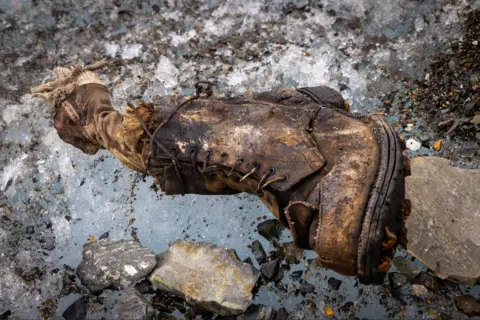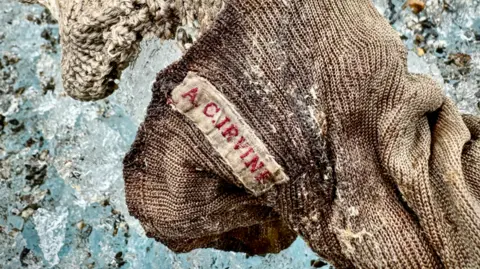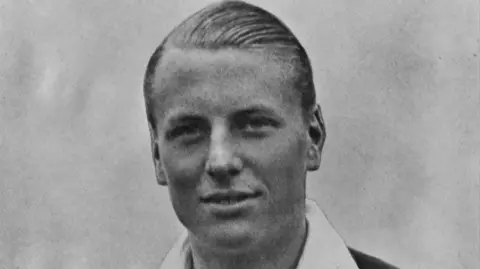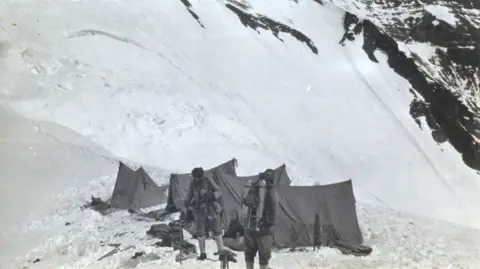Family tells of 'relief' after 1924 climber’s foot found on Everest
 Jimmy Chin
Jimmy ChinIt was the call the family of a young British climber who went missing on Everest 100 years ago had given up hope of ever getting.
Last month, a team of climbers filming a National Geographic documentary stumbled on a preserved boot, revealed by melting ice on a glacier.
This boot was believed to belong to Andrew Comyn "Sandy" Irvine, who disappeared while attempting to climb Everest in June 1924 with his partner George Mallory.
What's more, it could potentially help solve one of mountaineering's biggest mysteries: whether or not the pair succeeded in becoming the first people to reach the summit, 29 years before Edmund Hillary and Tenzing Norgay.
Well-known adventurer Jimmy Chin, who led the team for National Geographic, hailed the discovery of the boot - with a foot inside it - as a "monumental and emotional moment".
But for Irvine's great-niece Julie Summers it was simply "extraordinary".
"I just froze.... We had all given up any hope any trace of him would be found," she told the BBC.
A number of people have searched for Irvine's body over the years, partly because the 22-year-old is said to have been carrying a camera with an undeveloped film inside, potentially with a photograph of the pair at the summit.
Could the discovery of the boot be the first step to finding his body - and the camera?
The family have now given a DNA sample to help confirm the foot is indeed Irvine - but the filmmaking team is fairly confident it belongs to the mountaineer. The sock found inside the boot has a name tag stitched into it with the words "A.C. Irvine".
"I mean, dude... there's a label on it," Chin, who is known for making Oscar-winning climbing documentary Free Solo alongside his wife, was quoted as saying in a National Geographic report.
 Jimmy Chin
Jimmy ChinThe team made the discovery as they descended the Central Rongbuk Glacier by the north face of Everest in September.
Along the way, they found an oxygen bottle marked with the date 1933. An Everest expedition that year had found an item belonging to Irvine.
Energised by this possible sign that Irvine's body could be nearby, the team searched the glacier for several days, before one of them saw the boot emerging from melting ice.
It was a fortuitous find - they estimated the ice had only melted a week before their discovery.
The foot has since been removed from the mountain because of concerns that birds were disturbing it, according to reports, and passed to the Chinese mountaineering authorities who govern the north face of Everest.
For Irvine's descendants, the discovery has been emotional - especially in this, the centenary year of his disappearance.
Summers had grown up hearing stories of her grandmother's adventurous, Oxford-educated younger brother, who they knew as "Uncle Sandy".
"My grandmother had a photo of him by her bed until the day she died," she recalled. "She said he was a better man than anyone would ever be."
 Getty Images
Getty ImagesBirkenhead-born Irvine was just 22 when he disappeared, the youngest member of an expedition that has intrigued the mountaineering world for a century.
He and Mallory were last seen alive on 8 June 1924 as they set off for the peak.
Mallory's body would not be found until 1999 by an American climber. In recent decades, the search for the climbers' remains has been mired in controversy amid suspicions that the bodies were moved.
Summers has always dismissed those stories and suspicions, revealing her feeling of "relief" following the Chin's call that "he was still there on the mountain".
But what if it could now be proved that Irvine and Mallory reached the summit, becoming the first to do so - an idea which, Summers acknowledged, would "turn mountaineering history onto its head"?
"It would be nice - we would all feel very proud," she said. "But the family has always maintained the mystery, and the story of how far they got and how brave they were, was really what it was about."
And anyway, she said, "the only way we will ever know is if we find a picture in the camera he was believed to be carrying".
 Getty Images
Getty ImagesThe search, she suspects, will now continue for that camera. "I think it will be irresistible," she said.
Whether it will be found remains to be seen.
Chin, meanwhile, is hoping that the boot's discovery - "a monumental and emotional moment for us and our entire team on the ground" - will "finally bring peace of mind to his relatives and the climbing world at large".
For Summers, it is a chance to remind the world about a young man "who took life and lived it", embracing every opportunity - and above all, was "having fun".
But perhaps surprisingly, she and her cousins are grateful the older generation were not here for this discovery.
"For them, Everest is his grave," she explained.
